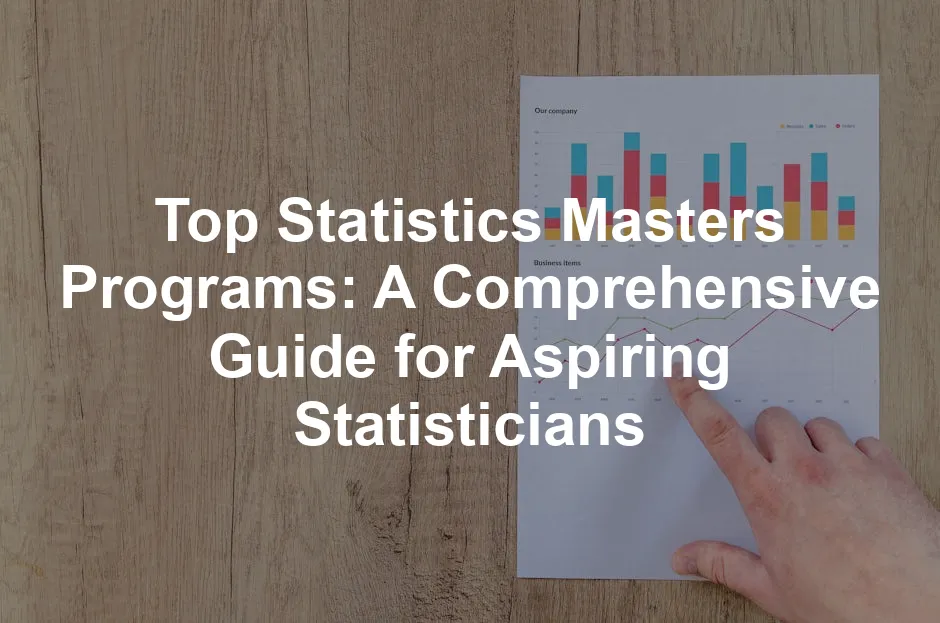Introduction
Statistics isn’t just boring numbers; it’s the language of data! In our data-driven world, statistics help us make sense of the chaos. From predicting election outcomes to determining the effectiveness of a new drug, statistics plays a pivotal role in countless fields. So, why not dive headfirst into this fascinating realm?
A master’s program in statistics equips students with advanced analytical skills. You’ll learn to collect, analyze, and interpret data like a pro, using cutting-edge software tools. Most programs cover essential topics such as probability, statistical methods, and data mining. Think of it as learning the secrets behind the numbers!
Choosing the right master’s program is crucial for your success. With many options available, it’s important to find a program that aligns with your career aspirations. After all, the right fit can open doors to lucrative job opportunities and a fulfilling career.
This article aims to list and analyze the top statistics master’s programs worldwide. Whether you’re looking at prestigious universities or specialized programs, this guide will help you make an informed choice. Let’s get started on your journey to becoming a statistics whiz!

Understanding Statistics Master’s Programs
What is a Master’s in Statistics?
A master’s in statistics is a graduate-level program designed to deepen your understanding of statistical theories and methodologies. The objective? To transform you into a skilled statistician, ready to tackle real-world data challenges.
Throughout the program, you’ll gain valuable skills. These include data analysis, statistical modeling, and research methodologies. You’ll also become proficient with statistical software, which is essential for any data-related job.
Core topics typically covered in these programs include:
- Data Analysis: Learn how to interpret complex data sets and derive meaningful insights.
- Probability: Understand the underlying principles that govern randomness and uncertainty.
- Statistical Methods: Explore various techniques for hypothesis testing, regression analysis, and experimental design.
- Data Mining: Discover how to extract useful information from large data sets.
In addition to these core topics, many programs offer electives in specialized areas such as biostatistics, machine learning, and survey methodology. This flexibility allows you to tailor your studies to your interests and career goals. For an excellent foundation in data science, consider checking out Data Science for Dummies.
A master’s in statistics not only prepares you for advanced roles in various industries but also opens pathways to doctoral studies. Whether you aspire to work in healthcare, finance, or government, this degree is your ticket to success in the data-driven job market.

Types of Master’s Degrees in Statistics
When considering a master’s in statistics, you’ll encounter two primary types: the Master of Science (MS) and the Master of Arts (MA). What’s the difference, you ask?
The Master of Science (MS) in statistics focuses heavily on quantitative skills and research methodologies. It’s often more rigorous, featuring a thesis component, and is perfect for those aiming for research or technical roles. If you’re the type who enjoys crunching numbers and diving into complex data analysis, this might be your go-to.
On the flip side, the Master of Arts (MA) in statistics leans more towards practical applications. It covers statistical methods with a focus on how they can be applied in real-world scenarios. This option is great for those looking to enter the workforce quickly, as it often emphasizes coursework over research. If you like to get your hands dirty right away, an MA might be the ticket.
Moreover, many programs offer specialized tracks. For instance, Biostatistics combines statistical methods with biological applications, perfect for those looking to enter the healthcare field. Data Science is another hot area, merging statistics with computer science to tackle big data challenges. These specialized programs provide targeted skills, making graduates highly sought after in their respective fields. If you’re interested in the intersection of data and business, check out Data Science for Business.

Ranking Methodologies for Statistics Programs
Overview of Ranking Criteria
When it comes to selecting the best master’s programs in statistics, rankings play a vital role. Various factors contribute to these rankings, including faculty expertise, research opportunities, and job placement rates.
Faculty expertise is crucial; after all, you want to learn from the best. Programs with renowned faculty members often offer richer learning experiences. The opportunity to engage in meaningful research is also essential. Programs that provide access to ongoing projects or labs can give you a significant leg up.
Job placement rates matter too. A program that boasts high placement rates indicates strong industry connections. Employers often trust graduates from well-regarded programs, making it easier to secure positions after graduation.
Lastly, program accreditation is pivotal. Accredited programs meet rigorous educational standards, ensuring you receive a quality education. The reputation of the institution itself can boost your resume, making it a vital consideration in your program choice. For a deeper dive into statistical methodologies, consider grabbing a copy of Practical Statistics for Data Scientists.

Major Ranking Systems
Several major ranking systems evaluate statistics programs, including the QS World University Rankings and U.S. News & World Report.
The QS Rankings focus on academic reputation, employer reputation, and research output. They provide a global perspective, ranking universities based on surveys and citation analysis. If you want to see how a program stacks up worldwide, this is a go-to resource.
On the other hand, U.S. News & World Report emphasizes factors like peer assessment and graduation rates. Their rankings often influence prospective students’ decisions, guiding them toward programs that are recognized for excellence.
For students, understanding these rankings is essential. They can significantly impact your choices and future opportunities. A high-ranking program often equates to better networking, internships, and job prospects. Thus, a well-researched choice can lead you down a fruitful career path!

Top Statistics Master’s Programs
1. Massachusetts Institute of Technology (MIT)
MIT consistently ranks as the best university for statistics. With its stellar reputation, the program attracts top-tier students who want to master data analysis. The curriculum is a blend of theoretical foundations and practical applications.
Students dive into advanced statistical methods, computational statistics, and data science tools. You’ll find classes that cover everything from probability theory to machine learning. This robust curriculum ensures graduates are well-prepared for the workforce. To enhance your understanding of data science tools, consider R for Data Science.
Career outcomes for MIT graduates are impressive. Alumni often land roles in tech giants, finance, or academia. The strong alumni network and industry connections help facilitate job placements and internships. If you’re looking to be at the forefront of statistics, MIT is the place to be!

2. Stanford University
Stanford’s Master of Science in Statistics is no slouch either. Known for its rigorous curriculum, the program focuses on both theoretical and applied statistics. Students learn from renowned faculty who are experts in their fields.
What sets Stanford apart is its interdisciplinary approach. Students can engage with other departments, such as computer science and engineering. This flexibility allows for a broader understanding of how statistics applies across various domains. For those interested in exploring statistical learning, you might want to grab The Elements of Statistical Learning.
Unique features include opportunities for research and collaboration with industry leaders. Graduates often find themselves in high-demand roles, thanks to Stanford’s strong connections in Silicon Valley. If innovation excites you, this program will not disappoint!

3. University of California, Berkeley
UC Berkeley boasts a Master of Arts in Statistics that’s well-regarded in the academic community. Key strengths include its emphasis on statistical theory and data analysis. The program offers a plethora of research opportunities, allowing students to dive into real-world problems.
Berkeley’s faculty consists of leading researchers who foster a collaborative learning environment. Students get involved in various projects, enhancing their practical skills. Alumni from Berkeley often shine in diverse fields, including public health, finance, and tech. If you’re interested in comprehensive data analysis, Python for Data Analysis is a fantastic resource.
Success stories from graduates highlight the program’s effectiveness. Many alumni have secured prominent positions in prestigious organizations. If you value research and hands-on experience, Berkeley is a fantastic choice!

4. Johns Hopkins University
Johns Hopkins offers a comprehensive Master’s in Statistics that prepares students for various careers. The program emphasizes strong analytical skills and a deep understanding of statistical concepts.
Students benefit from a curriculum that covers both theory and practical application. Courses range from biostatistics to data science, providing a well-rounded education. Faculty members are not only educators but also active researchers in their fields. For those keen on applying statistics in health sciences, Biostatistics: A Foundation for Analysis in the Health Sciences is an excellent read.
Career support services are a highlight of the program. Students receive guidance on internships, job placements, and networking opportunities. Graduates often find roles in healthcare, finance, and government. If career support matters to you, Johns Hopkins has you covered!

5. Princeton University
At Princeton, the Master of Science in Statistics offers a unique blend of theory and application. The program is small, ensuring personalized attention from faculty. Students can specialize in areas like biostatistics or machine learning.
Internship opportunities are integral to the curriculum, providing hands-on experience. The program also encourages collaboration with other departments, broadening students’ perspectives. This interdisciplinary approach enhances learning and prepares students for diverse careers.
Princeton’s alumni network is robust, with many graduates thriving in academia and industry. If you’re looking for a program that emphasizes individualized education and career readiness, Princeton is an excellent option! For a comprehensive introduction to statistical learning, An Introduction to Statistical Learning is highly recommended.

6. National University of Singapore (NUS)
The National University of Singapore (NUS) stands out for its strong emphasis on international perspectives and collaborations. This prestigious institution boasts a diverse student body from over 100 countries, creating a melting pot of ideas and cultural insights. NUS actively engages in partnerships with leading universities worldwide, enhancing its curriculum with global perspectives.
Students benefit from a unique blend of theoretical knowledge and practical applications. The program encourages collaborative projects that often involve international stakeholders. This means you won’t just crunch numbers in isolation; you’ll work on real-world problems with a global impact. Plus, NUS’s location in a vibrant city like Singapore adds to the experience, offering ample opportunities to connect with industry leaders and fellow statisticians from diverse backgrounds.

7. North Carolina State University
North Carolina State University (NCSU) is well-known for its practical applications and strong industry connections. The program emphasizes hands-on learning, ensuring students gain the skills needed to thrive in the workforce. NCSU’s collaboration with local industries and organizations allows students to engage in internships and real-world projects. This exposure is invaluable for mastering statistical techniques while also developing essential professional networks.
NCSU’s unique Integrated Analytics and Applied Statistics (IAAS) program combines rigorous coursework with practical experience. Students have access to cutting-edge technology and software, preparing them for modern statistical challenges. The close ties with companies such as SAS, founded by NCSU alumni, provide an excellent launchpad for careers in various data-driven sectors. To further enhance your understanding of data analysis, consider Data Analysis Using Regression.

8. Columbia University
Columbia University offers a Master of Arts in Statistics that is both flexible and comprehensive. Students can tailor their learning paths to suit specific interests, whether in data science, biostatistics, or applied statistics. The program is designed to accommodate both full-time and part-time students, making it accessible for working professionals.
One of Columbia’s strengths lies in its faculty, which includes leading experts in various statistical disciplines. This access to top-tier educators enriches the learning experience, allowing students to engage in cutting-edge research. Furthermore, Columbia’s location in New York City offers unparalleled networking opportunities in finance, technology, and healthcare, where statistics plays a crucial role. If you’re looking to enhance your data science skills, consider The Data Science Handbook.

9. University of Michigan, Ann Arbor
The University of Michigan, Ann Arbor, boasts a robust curriculum and state-of-the-art research facilities. The Master of Science in Statistics program emphasizes both theoretical foundations and practical applications. Students explore a variety of statistical methodologies and are encouraged to engage in hands-on projects.
Michigan’s research facilities are among the best in the nation, providing students with access to advanced tools and resources. The program encourages collaboration across disciplines, allowing students to apply statistical methods in fields like healthcare, engineering, and social sciences. Graduates emerge well-equipped to tackle complex data challenges in various industries. If you’re interested in the foundational aspects of statistical learning, consider reading Introduction to Probability.

10. Texas A&M University
Texas A&M University offers a Master of Science in Statistics that includes unique offerings and extensive career services. The program provides various tracks, including biostatistics and computational statistics, allowing students to focus on their interests. The curriculum combines theoretical knowledge with practical skills, ensuring graduates are industry-ready.
Career services at Texas A&M are robust, offering students resources for job placement, resume building, and networking events. The Aggie Network is a powerful tool, connecting graduates with a vast alumni base across various industries. This support is instrumental in launching successful careers in statistics and data analysis. If you’re looking for a comprehensive guide to data science practices, consider The Data Science Toolkit.

Factors to Consider When Choosing a Program
Location and Format
Geographical location plays a significant role in your educational experience. Consider the cost of living, local job market, and proximity to potential employers. Programs located in urban centers often provide more networking opportunities and internships. Additionally, think about the format of the program. On-campus, online, and hybrid options vary in terms of flexibility and engagement. Choose a format that aligns with your lifestyle and learning preferences.
Curriculum and Specializations
Examine the curriculum closely. Look for programs that offer a well-rounded education, covering core statistical theories and practical applications. Specializations can enhance your skill set, so consider programs that allow you to focus on areas of interest such as data science, biostatistics, or machine learning. Research opportunities are also vital. Programs that encourage thesis work or collaborative projects can provide invaluable hands-on experience.
Financial Considerations
Tuition costs can vary significantly between programs. Review the financial aid options available, including scholarships, assistantships, and grants. A thorough analysis of the potential return on investment (ROI) is crucial. Consider the average salaries of graduates from the program and the job placement rates. This information can help you determine whether the investment in your education will pay off in the long run.
Alumni Network and Career Support
A strong alumni network can be a game-changer for job placement. Research programs with active alumni associations that offer mentorship and networking opportunities. Additionally, consider the career support services provided by the institution. Programs with dedicated career counseling, internship placements, and job fairs can significantly ease the transition into the workforce. A robust support system can make all the difference in achieving your career goals after graduation.
Location and Format
When choosing a master’s program in statistics, location matters. Living expenses can vary dramatically. A program in a bustling city might offer unparalleled internship opportunities but could also hit your wallet hard. Conversely, studying in a smaller town might save you money, yet limit your access to prospective employers. So, weigh your options carefully!
Next up is the program format. Are you a night owl who prefers pajamas over pants? Online programs could be your jam! They offer flexibility and allow you to learn at your own pace. On-campus programs, however, provide face-to-face interaction and networking opportunities. Hybrid programs combine the best of both worlds. Choose a format that aligns with your learning style and lifestyle.
Curriculum and Specializations
Evaluating the curriculum is key to aligning your education with your career goals. Look for programs that cover essential statistical theories and applications. Are you aiming for a career in data science? Then focus on programs that emphasize machine learning and data mining. Biostatistics enthusiasts should seek specialized courses in healthcare applications.
Research opportunities are equally important. Programs that offer thesis options or collaborative projects can give you hands-on experience. This not only deepens your understanding but also enhances your resume. Plus, it allows you to make connections in the field, which can be invaluable down the road.
Financial Considerations
Tuition costs can be daunting, but don’t let them scare you away. Many programs offer financial aid, scholarships, and assistantships. It’s worth researching these options! A well-structured financial plan can make a world of difference.
Consider the potential return on investment (ROI) too. Graduates from top programs often see significant salary increases. For instance, statisticians can earn an average salary of around $92,270 per year. Weigh the costs against potential earnings to ensure your investment pays off.
Alumni Network and Career Support
A strong alumni network can be your secret weapon. Programs with active alumni associations often provide mentorship and job placement opportunities. Look for institutions that host networking events and have dedicated career services. These resources can help you secure internships and job leads, making your transition into the workforce smoother and more successful.
Conclusion
Choosing the right master’s program in statistics is a big deal! It can shape your career and future opportunities. With so many options available, assessing your personal goals is crucial. Ask yourself: What do you want to achieve? Whether it’s a focus on data science, biostatistics, or another specialty, make sure the program aligns with your aspirations.
Don’t forget to research thoroughly. Check out the curriculum, faculty expertise, and alumni success stories. These factors can provide valuable insights into a program’s quality and reputation. Remember, the right choice can pave the way for a fulfilling career in statistics, a field that is only getting more vital as data continues to dominate our world.
As the demand for statisticians grows, the future looks bright! Equip yourself with the right skills, and you’ll be ready to tackle the intriguing challenges that lie ahead in data analysis and beyond. So, grab your calculator, get those applications ready, and embark on your statistics adventure!
FAQs
What are the career prospects for graduates with a master’s in statistics?
Graduates with a master’s in statistics can pursue diverse roles. Common positions include data analyst, statistician, biostatistician, and market researcher. Industries range from healthcare to finance, and the demand for skilled statisticians continues to rise.
Is it necessary to have a background in mathematics to pursue a master’s in statistics?
While a strong foundation in mathematics is beneficial, it’s not always required. Many programs offer introductory courses to bridge gaps. However, having basic mathematical knowledge can ease your transition into more advanced topics.
Can I pursue an online master’s in statistics?
Yes, many reputable universities offer online master’s programs in statistics. These programs provide flexibility and often mirror the on-campus experience, ensuring you receive quality education without the commute.
How do I prepare for applying to a master’s program in statistics?
Start by gathering your application materials. This typically includes transcripts, letters of recommendation, and a personal statement. Highlight your relevant experiences and articulate your goals clearly. Some programs may also require GRE scores.
What is the average salary for statisticians with a master’s degree?
The average salary for statisticians with a master’s degree is approximately $92,270 per year. However, this can vary based on industry, location, and experience level, with some roles offering even higher compensation.
Please let us know what you think about our content by leaving a comment down below!
Thank you for reading till here 🙂
For a deeper understanding of statistical learning concepts, check out an introduction to statistical learning with python book length.
To enhance your skills in interpreting data, consider these tips for effective data analysis in economics and statistics.
For those interested in financial applications, explore statistical methods for finance professionals 2024.
For insights into genetic statistics, refer to mendelian genetics probability pedigrees and chi-square statistics.
If you’re considering further studies, look into the master of science in applied statistics for social science research.
To understand the educational requirements, check this ap statistics curriculum.
All images from Pexels




